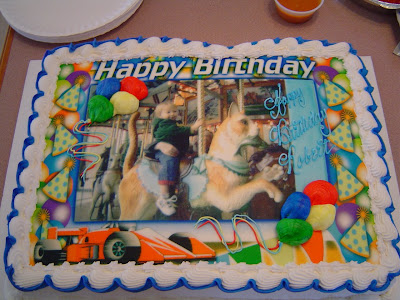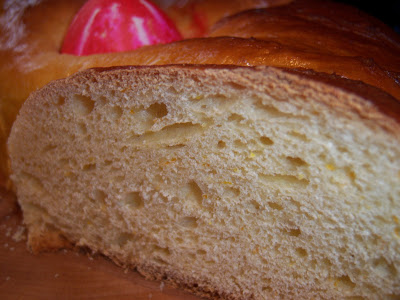Be careful what you wish for.
If you love to bake, as I do, and you have adorable nephews, as I do, and you have a very busy attorney-sister, as I do, and you offer to make your oldest nephew's first birthday cake, before you realize it you might find yourself -- five years and a second nephew later -- the family's official Birthday Cake Maker.
Not that I'm complaining about this status. February and March have become very busy months for me and my oven, is all I'm saying.
It all started in 2003 when I made a gigantic cake in the shape of a barn for Older Nephew's first birthday. It was a 13" x 9" two-layer chocolate cake, frosted with chocolate icing and topped with a smaller two-layer square chocolate cake that served as the barn. The pastures surrounding the barn were covered in green-dyed coconut (grass), except for the pig pen, which was topped with crumbled homemade chocolate cookies. I made the barn roof and fence from homemade chocolate cookies as well, cutting out the dough by hand to create the pieces I needed to construct the cake. The endeavor took me three evenings -- one to bake and prepare the chocolate cookies, one to bake the cakes and one to make the frosting and assemble the finished product. I even included little farm animals, as the finishing touches.
It was all very cute and charming until the candles were blown out and the adults got their hands on the animal figurines. Just goes to show you can't take my family anywhere.
When Older Nephew turned two in 2004, he was really into riding the yellow cat on the merry-go-round at Chapel Hill Mall. Sister ordered one of those cakes on which they screen an actual photograph on the frosting, so I was relieved of my bakerly duty that year. The cake was adorable nonetheless.
In 2005 he wanted a red car cake, so I found myself a VW Beetle-shaped pan and got to work with a whole bunch of pastry bags and various tips. This endeavor was a true adventure in frosting, as I had to create several vibrant hues to frost the cake properly -- including red and black, which are very difficult to make. (It takes a LOT of food coloring to saturate frosting so it's red and not pink and, well, the closest I could get with the black was a very dark gray.) The trick with this cake was returning the pastry bags and the cake-in-progress to the refrigerator quite often, as warm frosting does not pipe cleanly. At age three, Older Nephew was getting to the age where he really did appreciate his birthday cakes, and could articulate such to his tired-out, flour-covered, food-coloring-stained aunt.
Younger Nephew was born in 2005, so 2006 could have been a big year for me, the Birthday Cake Maker. But Sister made it easy on me and combined the boys' birthday parties. Older Nephew wanted a red car cake again, and as you can see, one year later I seem to have refined my method for making black frosting.
I recall Sister's telling me not to worry too much about Younger Nephew's cake, considering there was more than enough dessert to go around with the car cake. But he had to have something special, so I improvised and made a little cake with the black and yellow frosting left over from the car decorating.
Last year was interesting. Younger Nephew's birthday is in February, while Older Nephew's is in March. Younger Nephew requested a train cake, which was simple enough due to astounding advances in cake-pan technology (thanks, Williams-Sonoma!). I really enjoyed using a wide variety of candies and frosting colors/tips to decorate the train cars, and presented the cake to Younger Nephew on a tray of green-dyed coconut "grass." The tracks were Twizzlers, and the ties were Kit Kats. My favorite was the coal car, which I filled with malted milk ball "coal." Younger Nephew -- who loves candy so much that if he does not get as much as he thinks he deserves he will roll up into the fetal position on the kitchen floor like an addict and moan, "CANDY! CANDY!" -- was enamored with the train cake.
Older Nephew's fifth birthday was a month later, in March. Always trying to outdo his brother, he insisted that his cake portrayed something "heavier than a train." He asked me if a mountain weighed more than a train, and I replied that yes, indeed, a mountain is heavier than a train. So he asked for a mountain cake, with a train going around it. Because I own an obscene amount of kitchen goods and bakeware, I just so happen to have a series of concentric cake pans ranging from 3" diameter to 9". I baked a series of cakes in these pans, stacked them to form a rough pyramid shape, then iced them into a mountain peak. The green frosting is below the tree line; the brown is above the tree line where flora does not thrive. I carved a spiral track around the cake for the toy train to use as it ascended to the summit. I even threw in an out-of-scale mountain goat, just for good measure. Older Nephew was filled with glee.
So after several years of increasingly difficult and detailed cakes, imagine my delight when, in 2008, Younger Nephew requested a "green triangle cake with strawberries on top." A triangle! Frosted green! So easy! Sister tried her mightiest to complicate the issue, asking Younger Nephew repeatedly if he was sure he wanted a cake in the shape of a triangle. I was all, "Sister, when you bake the cakes, and my (non-existent) children ask for simple cakes after years of requesting heavy baked goods constructed like mountain ranges and modes of transportation, we will see how eager you are for me to keep suggesting that my children choose something more complex than a simple triangle." Younger Nephew stuck to his guns, so green triangle cake it was. I did form the strawberries into an "A," his initial, so there was a tad bit of creativity involved in this cake.
Which brings us to Older Nephew's sixth birthday, which was last Friday. His party with his school friends is this coming Sunday, however, due to the incredibly early arrival of Easter on March 23 and Sister's desire not to clutter an already-busy weekend with a bowling party for a bunch of six-year-olds. So I am baking the cake for this coming Sunday. Older Nephew is really into a computer engineering game called "Crazy Machines," which, frankly, is too hard for me to play. (Aunt Di can bake, to be sure, but is somewhat of an idiot with the engineering games.) When playing "Crazy Machines," one uses different components to build machines to do things like set off rockets, move soccer balls from one side of the screen to another, etc. Gears are one of the components available to construct the machine. Older Nephew is really into the gears, and asked me if I could make them into a cake. Remember what I said about being careful what you wish for?
So this weekend I will be hard at work transforming two 9" and one 6" cake into a unit of three interlocking gears, with teeth and a belt and everything. It has to look just like this, and since I will do anything my nephews ask me to do, of course I shall oblige:
The belt will be made from bubblegum tape, and I'm thinking maybe those small round pieces in the center of the gears can be mini Reese's Peanut Butter Cups. We'll see. All I know is, I have to get a pastry version of these very gears safely to a bowling alley by 3:00 on Sunday. I'll be sure to update this space with the end-game.
UPDATE: It is late Sunday night, and all gear-cake-making and bowling is over. Though this cake was quite laborious and patience-testing, I am very happy with the result. More important, Older Nephew was thrilled with his special cake, and lots of his friends at the party who have the same computer game thought it was "awesome," too. The best part: Older Nephew helped me decorate the cake, and translated each detail of each gear into its pastry form. He placed the Reese's Peanut Butter Cups, and asked if I could pipe some extra chocolate frosting around the Cups' circumferences to mimic the photo more accurately. Yes, Older Nephew's eye for detail belies his young age. The biggest cake-related hit had to be the "belt," which I ended up making out of sour gummy tape. I found it right next to the bubblegum tape in Discount Drug Mart's "random sugar treats that approximate office supplies" aisle, and the color was a much closer match. The kids LOVED eating it, too. Who would have thought sour gummy tape could be so universally appealing?
Next year, Older Nephew vows to request a cake "even more complicated." And I quote. But you know, I shall jump through whatever hoop he designates.
++++++
So this post is a little different, in that I'm not including an actual recipe. I wanted simply to highlight the fun I've had over the years bending to the cake-whims of the younglings. It has become a tradition in my family that I make the special cakes; indeed, even Dad got in on the action for his 64th birthday last year. He got a cake in the shape of his favorite libation.
Who knows what cakes the future holds? All I know is, I am ready with my myriad pans, pastry tips, fondant accessories and a rainbow of gel-paste food colorings.
Happy birthday, dear nephews!























































